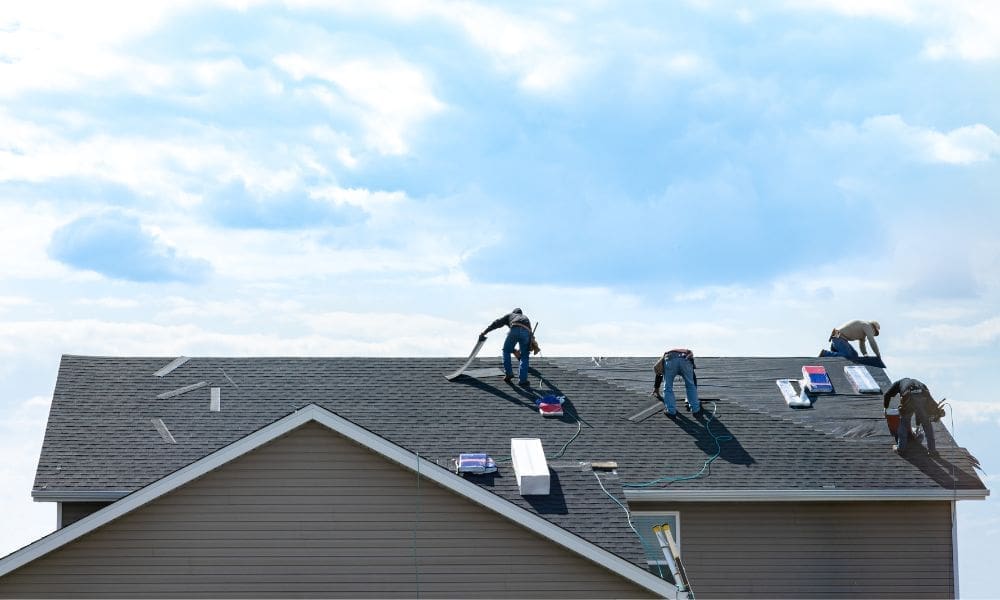Some people don’t know exactly how roofs protect a home, nor are they aware that an entire system exists underneath the shingles. That’s all going to change today. A roofing system is not the same as a roof. Learn more about this complex yet vital home system with this ultimate guide to residential roofing systems.
What Is a Roofing System?
Hidden beneath the shingles is an entire system that protects you and your family from external elements. The roofing system contains layers of materials that form a protective barrier against the outdoors. You might have been under the assumption that shingles were the only layer, but that’s not true. The shingles are the visible exterior covering, but much more happens underneath the shingles.
Roofing System vs. Roof
If a roof and roofing system are not the same, you might wonder about their differences. A manufacturer designs, tests, and produces all the layers and components of a roofing system. Then, they test all the materials together to decide which ones work and which ones don’t. This process leads to exceptional quality and consistency and ensures your roofing system will last.
When choosing a roofing system, look for a local roofing company that’s certified in the system’s installation process. This certification means they’ve received training, know the products, and understand how to install the system correctly.
A roof, on the other hand, includes the following components:
- Underlayment
- Shingles
- Ventilation
- Ice and water barrier
- Insulation
The difference is that these materials come from different manufacturers. Your contractor won’t have the certification, and you won’t know if all components work well together. You might have to replace the layers more often because of the potential for incompatibility.
Why Pitch Matters
The roof’s pitch, or slope, makes a difference in the longevity and performance of a roofing system. Typically, the steeper the angle, the more effectively water will flow off the roof. This design stops water, ice, and snow from pooling atop the roof. If your roof has little to no pitch, it may require more protective measures in the roofing system.
Knowing How the Roof System Works
Understanding how the roof system works will help you hire a great contractor to care for your roof. Awareness of the different components will help you ask the right questions and have a valuable conversation about the scope of work. For example, you can determine the necessary care for your roof and the available alternatives. Continue reading to explore the significant components of a roofing system.
Roof Structure
The roof structure is the roof’s foundation and consists of beams, rafters, and trusses. These components form the roof’s frame. Contractors will install the other components on top of the frame, creating a home’s attic space.
Decking/Sheathing
This crucial part of your roofing system contains plywood or oriented strand board (OSB). OSB is the less expensive option, and it’s the go-to for most homeowners. Plywood is more durable, costly, and heavier. Most contractors reserve plywood to use under dense roofing materials.
Sheathing and decking provide a layer above the joists and roof trusses that give the shingles something to attach to. It adds strength and protection to the roof system. The boards will evenly distribute the weight of rain or snow to stop the roof from sagging.
Underlayment
Underlayment is another layer of protection for your roof. Contractors install this waterproof or water-resistant material—rubberized asphalt, asphalt-saturated felt, or synthetic underlayment—on top of the sheathing or decking. You won’t have to worry about leaks when your roofing system has adequate underlayment.
If a strong storm comes through and damages shingles, the underlayment will stop rain from entering your home. This security prevents costly water damage that every homeowner hates.
Roof Coverings
Roof coverings are the visible part of the roofing system. Asphalt shingles are the most popular options in the United States, but that’s not the only choice for homeowners. When deciding on a roof covering, consider these factors:
- What is the climate like where you live?
- What aesthetic are you looking for?
Asking these questions will lead you to make the right decision on roof coverings.
Ventilation
A proper ventilation system can positively affect your energy bills and your roof’s lifespan. It’s important for things like stopping condensation from forming and preventing overheating. A roofing system’s ventilation allows air to flow freely underneath the roof and exit through roof vents.
All homes should have a ventilation system, even ones in mild climates. It can stop ice dams from forming in the winter and prevent mold in the humid summer season. Your contractor will work with you to find the right system for your home. It’s all about meeting your house’s unique needs!
Ventilation also regulates your entire home’s temperature. Hot air rises, and the vents allow the heat to escape in the warm months and keep it in during the cold months. Any home benefits greatly from this part of the roofing system.
Drainage
Designing the right drainage system for your roof has everything to do with the pitch. It consists of gutters and downspouts that allow rain, snow, debris, and ice to flow off the roof efficiently. Professionals install gutters around the perimeter, which connect to downspouts. The drainage system channels water and debris downward, stopping water and debris from accumulating on your roof or around your foundation.
Flashing
Professionals will install a thin piece of metal or plastic at the roofline and extend it to the rain gutters. The flashing is the connecting layer between spots where two roof sections form an angle. These areas are usually between the roofline and the gutters. Flashing also covers the areas that protrude from the roof, like vents, skylights, and chimneys. The purpose of flashing is to deflect water from vulnerable spots. You’ll typically see it between the underlayment and shingles.
Final Thoughts
Having general knowledge about residential roofing systems will help you make the right decisions for yours. Use this guide when you need to hire a contractor to build your roof. It will save you from a few headaches down the road and help you achieve a quality roofing system that lasts.




